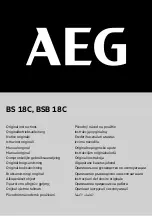
4
PXXX-3 Ed 1
7. Install the Rear Rotor Bearing Retainer (25)
in the groove on the rotor hub.
8. Align the dowel hole in both End Plates with
the one through the Cylinder, and insert a
guide rod 5/32” diameter x 6” long (3.9 mm
diameter x 152 mm long). Allow the rod to
protrude from the Rear End Plate.
9. Grasp the handle of the Motor Housing in
leather-covered or copper-covered vise jaws
so that the bore of the Motor Housing is
horizontal.
10.. Wipe a thin film of light grease on the End
Plate Gasket (32) and press the Gasket
firmly against the Rear End Plate.
11.. Insert the protruding end of the guide rod
into the dowel hole in the bore of the Motor
Housing, and slide the motor along the rod
until it is completely seated.
12.Remove the guide rod and replace it with
the Cylinder Dowel (27).
13.Reposition the Motor Housing in the vise so
that the open face of the Motor Housing is
upward.
14.Place the two Motor Clamp Washers (33),
convex side first, against the Front End
Plate so that the inner rim of the leading
Washer contacts the End Plate and the outer
rim of the trailing Washer contacts the
Hammer Case Pilot (38A).
15.Place the Rear Hammer Frame Washer (36)
over the hub of the Rotor and against the
Front Rotor Bearing.
Assembly of the Reverse Valve
1. Make certain the Reverse Valve Bushing
Seals (4) are properly located in the
undercuts in the Reverse Valve Bushing (3).
2. Dampen the Reverse Valve (12) with light
oil. Install the Reverse Valve Detent Spring
(14) followed by the Reverse Valve Detent
Ball (13) in the hole in the Reverse Valve.
With the Impactool in an upright horizontal
position, and while facing the handle end of
the Impactool, slowly rotate the Reverse
Valve and insert it from left to right in the
splined end of the Reverse Valve Bushing.
3. Apply a thread locking compound to the
Reverse Valve Knob Screw (16). Attach the
Reverse Valve Knob (15) to the Reverse
Valve with the Reverse Valve Knob Screw,
and tighten the Screw to 40 to 50 in-lb (4.5
to 5.6 Nm) torque.
Assembly of the Impact Mechanism
(Dwg. *TPD652*)
1. 1. Coat the Hammers (37) with a light film
of
Ingersoll-Rand
Impactool Grease No.
100.
2. 2. Replace the Hammers in the Hammer
Frame (34) exactly as they were when you
marked them prior to disassembly.
If you are installing new Hammers, or want
to change the location of the existing
Hammers to utilize both impacting surfaces,
slide the Hammers in the Hammer Frame so
that the half-round notch on one Hammer is
located on one side of the Frame and the
half-round notch on the other Hammer is
located on the other side of the Frame.
3. Replace the Hammer Pins (35).
4. Examine the base of the Anvil (43) and note
its contour. While looking down through the
Hammer Frame, swing the top Hammer to its
full extreme one way or another until you
can match the contour of the Anvil. Enter
the Anvil into the Hammer Frame and
through the first Hammer. Swing the bottom
Hammer in the opposite direction from the
top Hammer and maneuver the Anvil slightly
until it drops into the bottom Hammer.
Top Hammer
Wide Bevel UP
Top Hammer
Half-Round
Notch on RIGHT
Bottom Hammer
Wide Bevel DOWN
Bottom Hammer
Half-Round Notch on LEFT





















